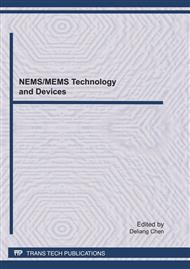p.99
p.103
p.107
p.111
p.115
p.120
p.124
p.128
p.132
Multi Degree-of-Freedom Micromotor Utilizing an Electrothermal Actuator Array and a Spherical Rotor
Abstract:
An electrothermally actuated planar micromotor has been developed for multi degree-of-freedom (DoF) motion, including rolling along the vertical or horizontal axes, spinning about the z-axis, and also the out-of-plane piston motion. In this design, a light-weight spherical solder ball rotor with plastic core is supported by electrothermal actuator array (EAA). Each bimorph actuator consists of the silicon and aluminum layers to produce large vertical deflection due to their distinct coefficients of thermal expansion (CTE). The micromotor fabrication procedures involve standard CMOS-MEMS processes. Rolling and spinning motions of the spherical rotor are performed by driving the electrothermal actuators with multi-phase signals, and the piston motion can be achieved by synchronizing the drive signals to all actuators without phase difference. The dynamic behavior of this micromotor has been successfully predicted by multibody dynamics simulation software. Such unique dynamic motions of this planar micromotor device show promising capabilities in Optical Coherence Tomography (OCT) and Optical Coherence Microscope (OCM) applications. If this sphere is mounted with a highly-reflective mirror platform, it can be used to divert the light beam to achieve a full 360° circumferential scan about the optical axis.
Info:
Periodical:
Pages:
115-119
Citation:
Online since:
May 2011
Authors:
Price:
Сopyright:
© 2011 Trans Tech Publications Ltd. All Rights Reserved
Share:
Citation:


